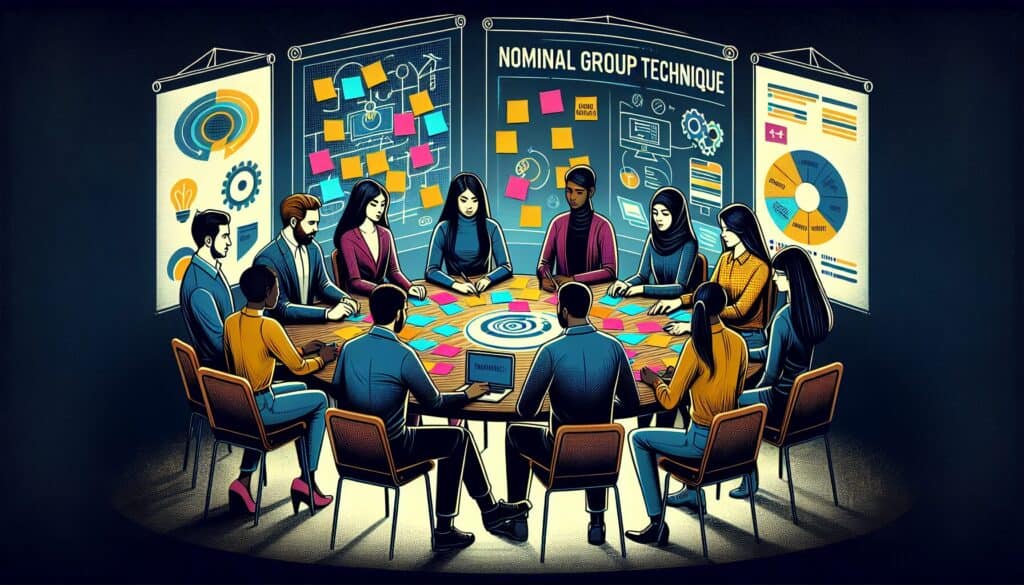To generate and prioritize ideas or solutions from a group in a structured way that encourages equal participation.
- Methodologies: Customers & Marketing, Economics, Lean Sigma, Manufacturing, Project Management, Quality
Nominal Group Technique

Nominal Group Technique
- Brainstorming, Continuous Improvement, Cross-Functional Collaboration, Design Thinking, Ideation, Innovation, Teamwork, User-Centered Design, Value Proposition
Objective:
How it’s used:
- Participants individually generate ideas in writing, then share them one by one in a round-robin format. Ideas are discussed, and then participants individually rank or vote on the ideas to prioritize them.
Pros
- Ensures all members contribute; reduces dominance by a few individuals; provides a structured and efficient way to reach a group consensus.
Cons
- Can be more time-consuming than unstructured brainstorming; may feel restrictive to some participants; the quality of outcomes depends on the clarity of the problem statement.
Categories:
- Ideation, Problem Solving, Project Management
Best for:
- Generating and prioritizing ideas from a group while ensuring balanced participation.
Nominal Group Technique (NGT) finds utility across various industries such as healthcare, technology, education, and product design, particularly during the early phases of innovation and project development when teams seek to harness diverse perspectives and prioritize concepts. This structured approach can be particularly beneficial during brainstorming sessions held to identify new products, features, or improvements to existing offerings. Participants, typically comprising a cross-functional team including engineers, designers, market analysts, and stakeholders, engage in a round-robin format which serves to level the playing field, ensuring that quieter members have an opportunity to voice their ideas without being overshadowed by more dominant personalities. The emphasis on anonymity in the initial idea generation phase minimizes peer pressure, allowing for a broader range of thoughts that might otherwise remain hidden in traditional brainstorming settings. Following the sharing of ideas, the subsequent discussion phase allows participants to seek clarification, build upon suggestions, and refine their understanding before voting on the proposed solutions, which leads to the identification of those with the highest consensus among the group. This technique not only promotes collaboration but also results in actionable outcomes that have been synthesized from group input, making it suitable for complex design challenges where stakeholder buy-in is critical to the success of the project. Furthermore, NGT can be effectively employed in strategic planning sessions and focus groups, facilitating a democratic process that prioritizes ideas based on collective agreement, thereby paving the way for innovative breakthroughs in product development and organizational strategy.
Key steps of this methodology
- Participants generate ideas individually in writing.
- Ideas are shared one by one in a round-robin format.
- Each idea is discussed and clarified by the group.
- Participants individually rank or vote on the ideas.
- The rankings are tallied to prioritize ideas.
Pro Tips
- Encourage participants to draft multiple ideas initially, as this can stimulate deeper thinking and prevent fixation on a single concept during discussion.
- Use anonymous voting methods for ranking to minimize bias and influence from dominant personalities, leading to more honest feedback.
- Implement time limits for each stage—idea generation, discussion, and voting—to maintain a dynamic pace and maximize engagement from all participants.
To read and compare several methodologies, we recommend the
> Extensive Methodologies Repository <
together with the 400+ other methodologies.
Your comments on this methodology or additional info are welcome on the comment section below ↓ , so as any engineering-related ideas or links.
Historical Context
1960
1980
1983
1990
1995
2000
2010
1950
1980
1980
1986
1994
1995
2000
(if date is unknown or not relevant, e.g. "fluid mechanics", a rounded estimation of its notable emergence is provided)














Related Posts
Musculoskeletal Discomfort Questionnaires
Multivariate Testing (MVT)
Multiple Regression Analysis
Motion Capture Systems
MoSCoW Method
Mood’s Median Test